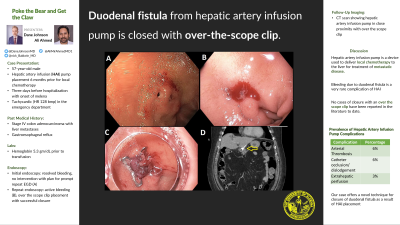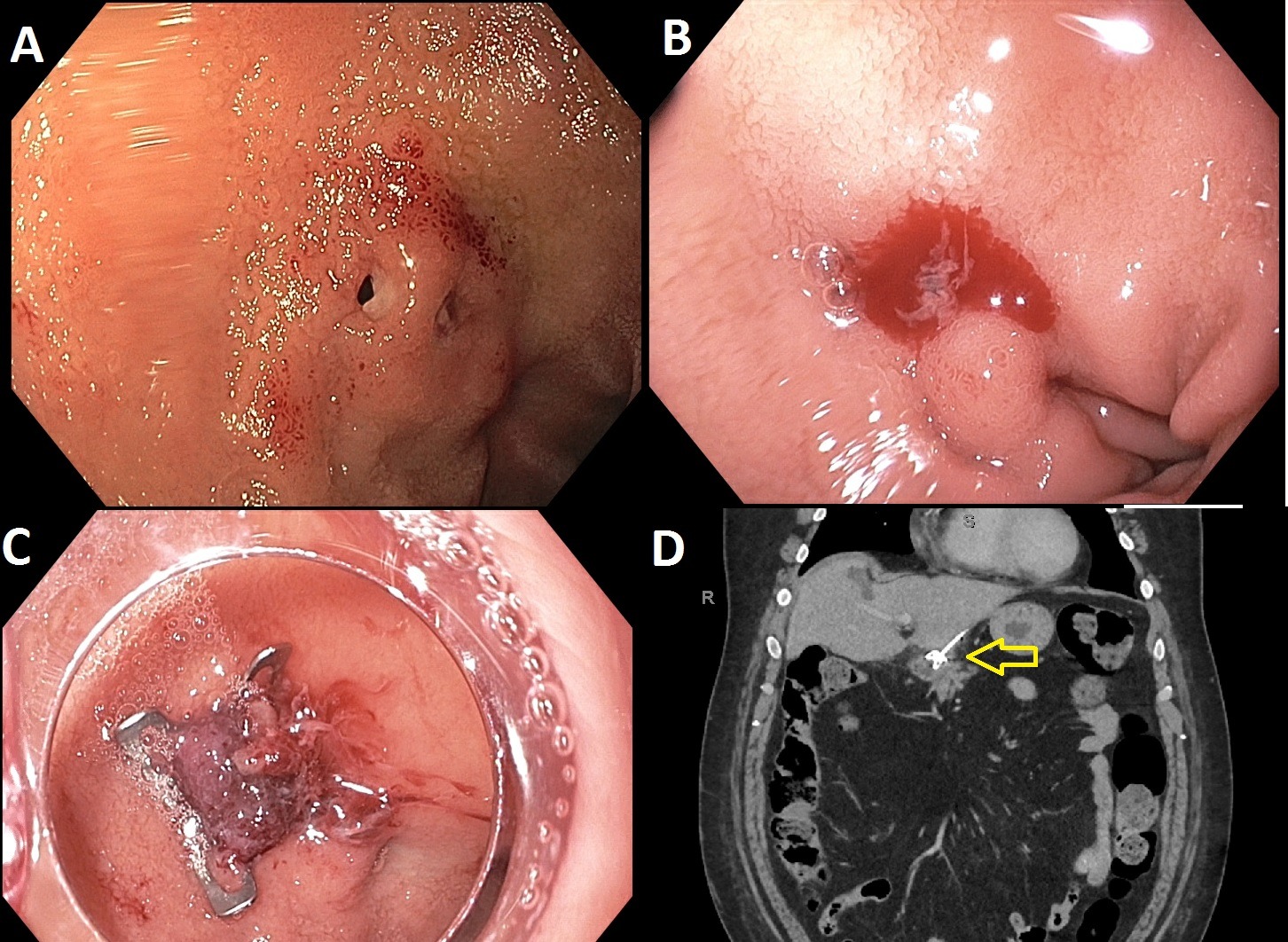Back


Poster Session B - Monday Morning
Category: Interventional Endoscopy
B0471 - Poke the Bear and Get the Claws: Life-Threatening Bleeding by Hepatic Artery Infusion Pump Fistula Managed by Over the Scope Clip Closure
Monday, October 24, 2022
10:00 AM – 12:00 PM ET
Location: Crown Ballroom

Has Audio
- DJ
Dane T. Johnson, MD
University of Alabama at Birmingham
Birmingham, AL
Presenting Author(s)
Dane T. Johnson, MD, Nicholas Baldwin, MD, Ali M. Ahmed, MD
University of Alabama at Birmingham, Birmingham, AL
Introduction: Hepatic artery infusion (HAI) pumps may be used for regional delivery of chemotherapy for treatment of colorectal cancer liver metastases. Complications are rare, but can include arterial thrombus and catheter dislocation. We present a case of duodenal fistula associated with hepatic artery infusion pump and subsequent closure with over the scope clip.
Case Description/Methods: We present the case of a 57-year-old male with stage IV colon adenocarcinoma and liver metastasis who underwent placement of hepatic artery infusion (HAI) pump for local chemotherapy. 6 months later, he presented with 3 days of melena and fatigue with vitals demonstrating heart rate 129 bpm and blood pressure was 111/69 mmHg. Notably, hemoglobin was 9.1 g/dL, down from a baseline of 14.4 g/dL. He was admitted to the surgical oncology service and gastroenterology was consulted for suspected upper GI bleed. Esophagogastroduodenoscopy (EGD) performed the day after admission revealed suspected fistula in the duodenal bulb. Bleeding resolved with proton pump inhibitor therapy alone with plan for outpatient repeat endoscopy. 1 month later the patient presented with anemia, melena and acute blood loss. Repeat EGD demonstrated a bleeding duodenal bulb lesion and hemostasis was achieved by placement of a 12/6t over the scope clip placement. Subsequent CTA scan identified the hepatic artery infusion pump tip adjacent to over the scope clip in the proximal duodenum with no extravasation suggesting resolution of bleeding after clip placement.
Discussion: We present a rare case of duodenal bleeding due to hepatic artery infusion catheter tip dislocation. A large single center experience of 544 patients over a 15-year period demonstrated the most common complications from HAI to include arterial thrombosis (6%), catheter occlusion/dislodgement (6%) and extrahepatic perfusion (3%)1. Furthermore, literature search for cases from 1975-2022 reveals fewer than 10 cases with this bleeding complication. In this case we demonstrate the successful use of an OTSC to manage bleeding associated from the fistula created by the infusion pump catheter between hepatic artery and duodenal bulb.

Disclosures:
Dane T. Johnson, MD, Nicholas Baldwin, MD, Ali M. Ahmed, MD. B0471 - Poke the Bear and Get the Claws: Life-Threatening Bleeding by Hepatic Artery Infusion Pump Fistula Managed by Over the Scope Clip Closure, ACG 2022 Annual Scientific Meeting Abstracts. Charlotte, NC: American College of Gastroenterology.
University of Alabama at Birmingham, Birmingham, AL
Introduction: Hepatic artery infusion (HAI) pumps may be used for regional delivery of chemotherapy for treatment of colorectal cancer liver metastases. Complications are rare, but can include arterial thrombus and catheter dislocation. We present a case of duodenal fistula associated with hepatic artery infusion pump and subsequent closure with over the scope clip.
Case Description/Methods: We present the case of a 57-year-old male with stage IV colon adenocarcinoma and liver metastasis who underwent placement of hepatic artery infusion (HAI) pump for local chemotherapy. 6 months later, he presented with 3 days of melena and fatigue with vitals demonstrating heart rate 129 bpm and blood pressure was 111/69 mmHg. Notably, hemoglobin was 9.1 g/dL, down from a baseline of 14.4 g/dL. He was admitted to the surgical oncology service and gastroenterology was consulted for suspected upper GI bleed. Esophagogastroduodenoscopy (EGD) performed the day after admission revealed suspected fistula in the duodenal bulb. Bleeding resolved with proton pump inhibitor therapy alone with plan for outpatient repeat endoscopy. 1 month later the patient presented with anemia, melena and acute blood loss. Repeat EGD demonstrated a bleeding duodenal bulb lesion and hemostasis was achieved by placement of a 12/6t over the scope clip placement. Subsequent CTA scan identified the hepatic artery infusion pump tip adjacent to over the scope clip in the proximal duodenum with no extravasation suggesting resolution of bleeding after clip placement.
Discussion: We present a rare case of duodenal bleeding due to hepatic artery infusion catheter tip dislocation. A large single center experience of 544 patients over a 15-year period demonstrated the most common complications from HAI to include arterial thrombosis (6%), catheter occlusion/dislodgement (6%) and extrahepatic perfusion (3%)1. Furthermore, literature search for cases from 1975-2022 reveals fewer than 10 cases with this bleeding complication. In this case we demonstrate the successful use of an OTSC to manage bleeding associated from the fistula created by the infusion pump catheter between hepatic artery and duodenal bulb.

Figure: A: Index endoscopy showing fistula in the bulb of the duodenum. B: Subsequent endoscopy with bleeding fistula. C: Fistula closure and successful hemostasis with over the scope clip. D: CT scan showing clip with close approximation to the hepatic artery infusion catheter tip
Disclosures:
Dane Johnson indicated no relevant financial relationships.
Nicholas Baldwin indicated no relevant financial relationships.
Ali Ahmed indicated no relevant financial relationships.
Dane T. Johnson, MD, Nicholas Baldwin, MD, Ali M. Ahmed, MD. B0471 - Poke the Bear and Get the Claws: Life-Threatening Bleeding by Hepatic Artery Infusion Pump Fistula Managed by Over the Scope Clip Closure, ACG 2022 Annual Scientific Meeting Abstracts. Charlotte, NC: American College of Gastroenterology.
